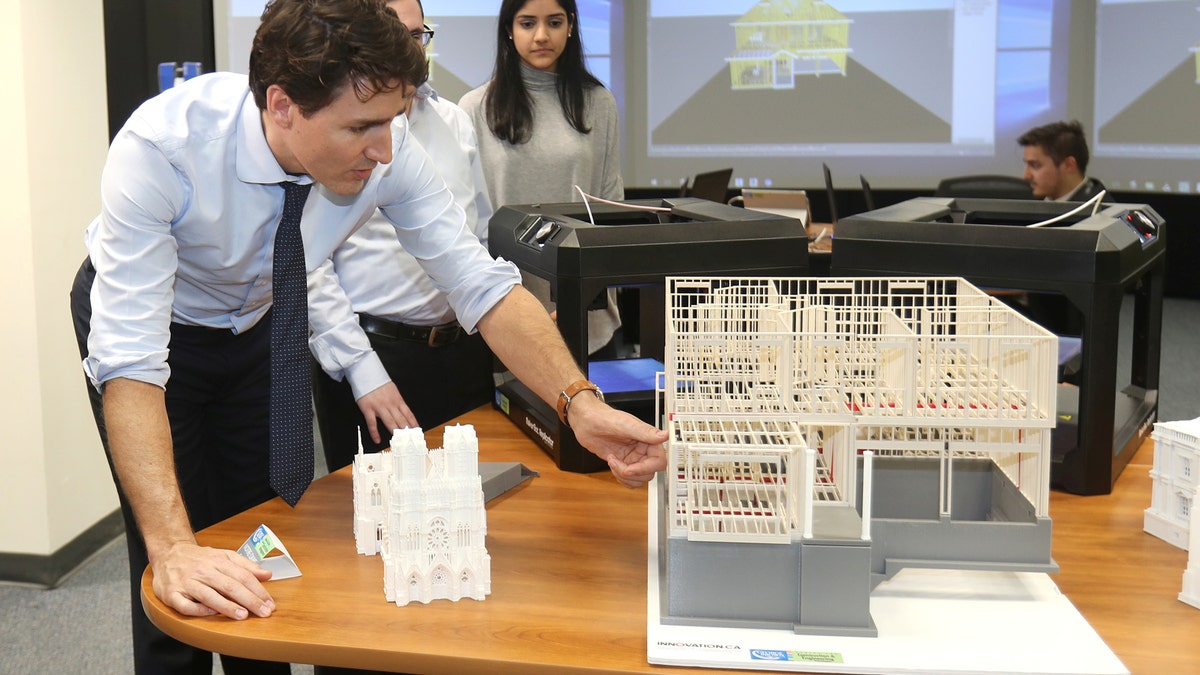
File photo: Canada's Prime Minister Justin Trudeau looks at construction models created by 3D printers at the George Brown College Casa Loma campus in Toronto, Ontario, Canada March 23, 2017. (REUTERS/Fred Thornhill)
Researchers at MIT have developed a system with the capability to create a large-scale building using 3D-printing technology.
The system, known as a Digital Construction Platform (DCP), consists of a tracked vehicle that carries a giant, robotic arm with a smaller precision-motion robotic arm at its end. The smaller arm is highly controllable and constructs the prototype structure. It directs a construction nozzle, similar to one used to pour concrete or spray insulation material. It also utilizes digital fabrication end effectors, such as a milling head, according to MIT.
The DCP is inspired by MIT’s Mediated Matter group’s desire to be able to design buildings without parts. MIT wrote that the plans include “combining ‘structure and skin,’ and beams and windows, in a single production process, and adapting multiple design and construction processes on the fly.”
Researchers were able to build an initial dome-shaped structure comprised of walls reaching 50 feet in diameter and 12 feet in height. The team said it took less than 14 hours to "print" the entire structure. The system also showcased its ability to create complex shapes and overhangs and created a built-in bench for the dome prototype.
MIT did not respond to further request for comment from Fox News.
MIT added the construction method fills polyurethane foam molds with concrete and it is similar to traditional commercial techniques. Researchers found the system was able to adapt to existing building sites and equipment, and it fits existing building codes without requiring additional evaluations. Other materials such as wiring or plumbing are inserted into the mold before concrete is poured, creating a completed wall structure, according to MIT.
The group hopes to create an end product that is self-sufficient and able to use local materials, such as dirt for the construction. The team envisions a future system that uses solar power and can be used in developing worlds or in disaster areas after storms or earthquakes.
MIT added that Steven Keating, Ph.D., a mechanical engineering graduate and former research affiliate in the Mediated Matter group at the MIT Media Lab, said the team hopes “in the future, to have something totally autonomous, that you could send to the moon or Mars or Antarctica, and it would just go out and make these buildings for years.”
Keating led the development of the system as his doctoral thesis work. He added that it creates a more environmentally friendly and ecologically conscious process, as fewer materials are used in the process because it can optimize components for their shape and thickness. Traditional construction requires the need to match premade lumber and materials.
Neri Oxman, group director and associate professor of media arts and sciences, added that the faster, better and cheaper aspects are positive. However, it is not just a printing system “but an entirely new way of thinking about making, that facilitates a paradigm shift in the area of digital fabrication, but also for architectural design,” said Oxman. “Our system points to a future vision of digital construction that enables new possibilities on our planet and beyond.”
The robotic system was described in the journal "Science Robotics."




















